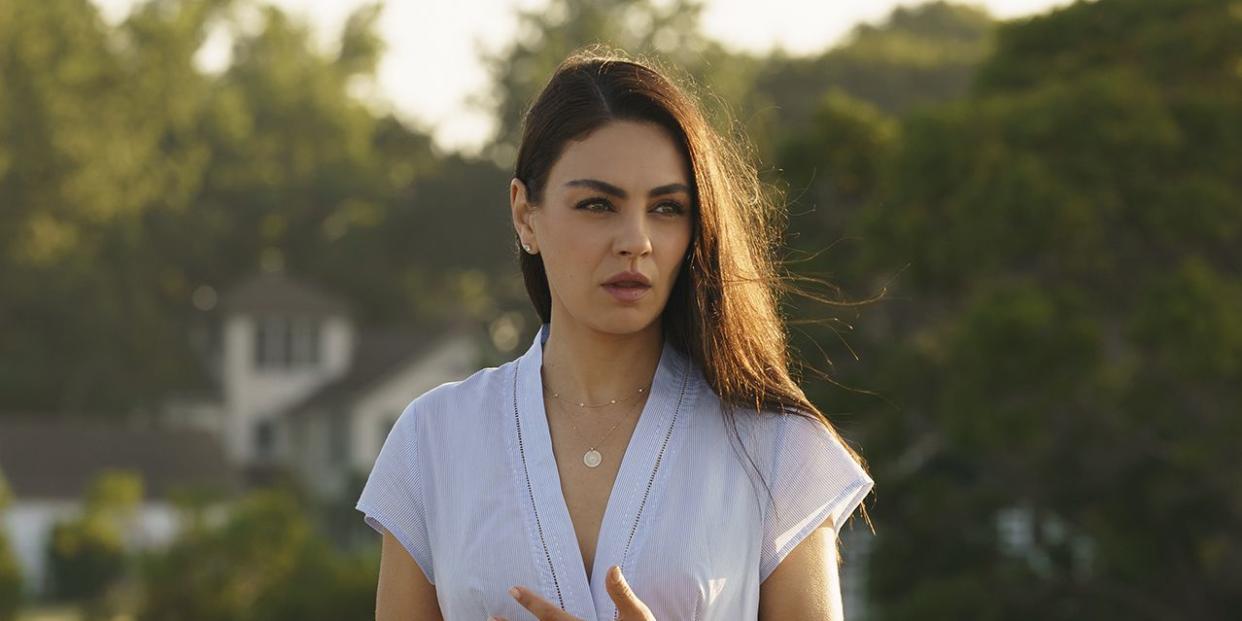It Took The 'Luckiest Girl Alive' Author Years To Realize What She'd Experienced

*Trigger warning: Sexual assault, abuse, gun violence*
Netflix’s new hit film, Luckiest Girl Alive, starring Mila Kunis, is actually based on the best-selling book (of the same name) by Jessica Knoll. The movie, like the book, is complex and intense, telling the story of a woman named TifAni FaNelli ("Ani") who has a successful career in journalism, a rich fiancé, and a promising future. But all that success masks a very disturbing past, which she has to revisit on a trip back home.
In the movie, the audience learns that Ani is actually a survivor of a brutal sexual assault, having been gang raped by a group of boys from her private high school. As her community questions her narrative and assumes she was a willing participant, teenage Ani is left trying to pick up the pieces. But it doesn't end there. Two of her friends eventually bring guns to school and end up shooting the classmates who were involved in the rape.
The story is disturbing and Knoll only began speaking about the true origins of her novel after it was published. So, is Luckiest Girl Alive a true story? Here’s what you need to know.
Is it based on a true story?
Yes, the book is partly based on a true story. In Knoll's dedication, she wrote, “To all the TifAni FaNellis of the world, I know,” which made a lot of people wonder if Knoll was hinting that she personally understood about the sexual trauma. Knoll says women would often approach her about the book and its contents, but that she brushed off any questions or comparisons for a long time, assuring them that the story was fictional.
But later, Knoll opened up about her traumatic experiences in an essay for the Lenny Letter newsletter, spelling out her own connection to Ani's story. And it was pretty intense.
The sexual assault in the story is based on real life experiences.
Knoll explained in the newsletter how her experiences meeting women and not sharing the truth ultimately led her to speak out. “It really killed me to see the looks on these women's faces when I would say, ‘Oh no, you know, I just made it up,’ and I just never wanted to see that look on anyone's face again,” she said.
Knoll also suggested that she had trouble admitting to herself what had happened. “The first person to tell me I was gang-raped was a therapist, seven years after the fact,” she wrote. “The second was my literary agent, five years later, only she wasn’t talking about me. She was talking about Ani, the protagonist of my novel, (1), which is a work of fiction. What I’ve kept to myself, up until today, is that its inspiration is not.”
Knoll has said that she was raped by boy she had a crush on (she refers to him only as “A Boy”), as well as at least two other boys.
“I know I woke facing a bare back. There was a nauseating moment where I had no idea where I was and whom I was with, but that if it had to be anyone, at least let it be A Boy. Please let it be A Boy. Then he turned over. He wasn’t A Boy,” she wrote in the essay. “He was Another Boy, A Third Boy, one I didn’t like or find the least bit attractive. He laughed about how hungover he was, how crazy the party had been, how the reason I couldn’t find my underwear was because it was downstairs.”
The school shooting is not based on real events.
In the movie, Ani's friend takes a gun to school and shoots the boy who raped her. But this didn’t happen in real life. Knoll said she added the shooting because she didn’t think what happened was “bad enough.”
"I still had the idea in my head that what happened to Ani wasn't bad enough, because that's what happened to me,” she said. “I thought I had to make it worse."
Lots of biographical details about Ani and Knoll are similar.
Ani was 28 at the time Luckiest Girl Alive takes place and Knoll shared in her essay that she was also 28 when she wrote the book. “Like Ani, I grew up in the suburbs and attended a tiny private high school where, surrounded by old-money Ivy League strivers, I was a bit of an outlier,” she wrote in the essay. “In adulthood, Ani writes about sex for The Women’s Magazine; I was an editor at Cosmopolitan for the first five years of my career.”
Ani also went public with her story.
In the movie, Ani eventually goes public with her story, although in a slightly different way than Knoll does IRL. The movie also shows that the reactions Ani's story gets from other women are similar to those Knoll experienced.
You Might Also Like

